Ward off colds and flus this winter with a humble herbal steam, a much loved preparation in all herbal traditions that’s simple to make, affordable and soothing to the whole body and soul. If you’ve ever had a warm cup of herbal tea and inhaled the vapours, you’ll know that hot herbal infusions can clear the nasal cavity and make breathing easier. Or if you’ve use aromatic shower bombs and smelt the vapours clearing your head as you shower, which is the same principle. Steaming herbs releases the volatile oils in the herbs, allowing them to fight microbial, bacterial and viral pathogens accumulating in your nasal cavity. The herbal steam technique is the first therapy you can whip up at the first signs of a cold or flu. Discover how to create your own herbal steam and keep your upper respiratory passageways clean, calm and moist over the cooler seasons.
For the past decade I’ve been teaching the next generations of naturopaths to manufacture herbal medicines at university and colleges throughout Australia, and I’d love to share one of the simplest ways you can use herbs in autumn and winter. No complicated solvents or month-long macerations involved. This is simple home herbalism and it’s perfect for the whole family. I’m taking about Herbal Steams. This is also one of the oldest types of herbal treatments, considering naturopathy has its roots in water-therapies. Herbs were used in steaming baths in ancient India and recorded in the Vedas and they were popular in ancient Egypt, China and in bath houses all over the world. What herbs were they using? Rose, Peppermint, Cinnamon, Frankincense, Lavender, White Lily, Marjoram and Oregano mostly. These are herbs that alleviate skin conditions and fight infection, but many like Lavender, also help you relax and unwind. And we know from modern research that herbal steams can help us sleep better. Along with fresh or dried herbs, resins and oils were added for additional benefit. There’s long tradition of thalassotherapy (medicinal bathing) where you see herbs being selected specifically to heal illness and disease. 1
Here’s what scientific studies recommend using a herbal steam for:
- Blocked nasal passages
- Nasal congestion, stuffy nose
- Cough, colds, influenza
- Foggy mind
- Insomnia (chronic) 12
- As a skin purifier
- Chronic Obstructive Pulmonry Disease (supportive) 11
A bit about Herbal Steams
Classical herbal steams use a combination of herbs, minerals and hot water to break through congestion and blockage in the upper respiratory system and to fight pathogenic infection. If you’re making an inhalation you’ll be leaning over a steaming bowl of water and herbs. These are simple to make but best for those over 12 years old, as there’s always a risk of children burning their skin with hot water. Herbal baths though, suit everyone. An additional benefit of herbal steams is their cleansing effect on skin, moistening and softening facial skin and boosting circulation. So if you suffer from acne or other congestive skin conditions, herbal steams can be a simple treatment to gently cleanse and fight bacterial infection from Propionibacterium acnes.
Inhalations are a traditional approach to combatting respiratory infection and they’re used in Eastern and Western holistic healing systems. Your nose isn’t just an olfactory organ, it’s a filter cavity that filters the air you breathe in, and it’s coated with moist mucous membranes that capture dust, foreign particles or pathogens and help to remove them from your body as you sneeze, blow your nose, or even just as a process of your mucous encapsulating the pathogens. These mucous membranes are incredibly sensitive to climate and environmental changes.
Ideally your nasal passageways are always moist, but as most of us know, when we catch a cold once of the first things we can feel is the imbalance that develops in our nose and throat. Whether we get too dry or too clogged up with phlegm. 2
Use your herbal steam blend in these ways:
- Add 2 cups to a steaming, warm bath and soak for 15-20 minutes, using deep breathing to inhale the vapours. Discard the herbs afterwards.
- Add ½ cup to a small glass bowl of hot boiled water, sit over the bowl and inhale the vapours, covering yourself and the bowl with a towel to prevent loss of vapours. Do this for 5 minutes or so until and take breaks if you feel the steam is too hot for your skin. This helps focus the vapours in the nasal cavity.
- If you have a wood-burner, consider placing a small pot on the top of the burner (if suitable and safe) containing water and ½ cup of your herbal steam blend. The vapours will help purify and moisten the air.
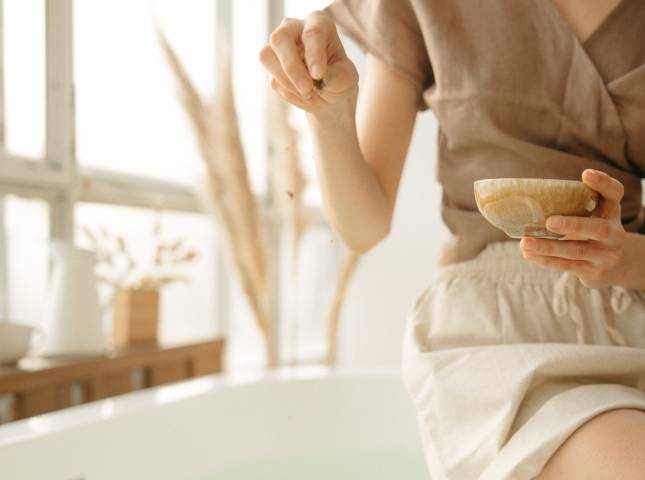
Photo: Yaroslav Shuraev
Lots of herbs can be used in steams and I think you probably have some in your pantry that you can use right now to get started. Eucalyptus (Eucalyptus globulus), Thyme (Thymus vulgaris) and Ginger (Zingiber officinale) for instance. You can always start with a small group of herbs and gradually build up your herbal steam collection as you go along.
A 2021 study of Indian steaming herbs found positive associations between herbal nasal steams and relief of influenza symptoms. They focussed on COVID, but this is relevant to viral infections that enter via the nasal passages overall. Eucalyptus was a standout herb, and Justicia adhatoda also emerged as a powerful inhalation herb for cough, cold and whooping cough (pertussis). Another herb that performed well in the study was Nirgundi (Vitex negundo). 3
Herbal Steams in Ayurveda
The Ayurvedic approach focusses on restoring balance to the nasal passageways with herbal therapies that suit the constitution of the patient, using a variety of methods including nasal oils, nasal washes, face massage, steam therapies and of course, herbal remedies.
Ayurveda uses herbal teas and decoctions applied into the nasal passages as a key method of treating respiratory complaints. It’s called nasal therapy (Nasya), and then you have steam inhalations which are applied to the whole body, not just inhaled through the nose. They also make herbal ‘snuff’ powders that you can easily mix yourself, which are gently applied into the nose, perhaps with a little sesame oil to aid absorption. Neti pots are a wonderful, easy (and strangely pleasurable) way to clean your nasal passages and loosen up and remove accumulated phlegm. You can prepare a warm herbal infusion with this herbal steam blend and use it in your neti pot just once a day (don’t over do it). 4
If you do decide to apply oil into your nasal area, note that you shouldn’t swallow the oil. Also, the oil is best administered when you’re in a supine or lying position with your head slightly tilted, and it’s best applied warm to increase blood flow in the head and neck and support the clearing activity of the mucous. 4
How to make your herbal steam and inhalation blend
You can make your own herbal steam blend by choosing which herbs suit your purposes (see below) and buy them in dried, organic form. Mix with epsom salts and Himalaya pink salt crystals and store in a glass jar for up to 12 months. Add them to facial steams, hot baths or as you wish.
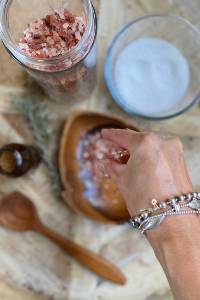
{ .1. }
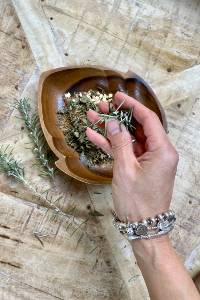
{ .2. }
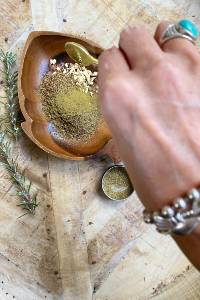
{ .3. }
If using dried ingredients you can store your mix for up to a year. But if using fresh, you’ll need to discard it after 24 hours. Combine the ingredients and feel free to experiment with the herbs you use. I’ve used some Lemon Myrtle and Rosemary as you can see above. You might want to use Tea tree or fresh Eucalyptus leaves.
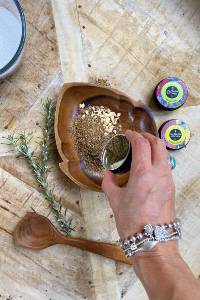
{ .1. }
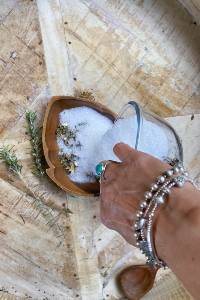
{ .2. }
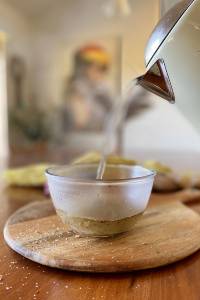
{ .3. }
Once your herbal steam blend is ready you can use it immediately. Either by preparing an inhalation, adding hot boiled water to a 1/2 cup of your blend and inhaling. (above right) or adding to a bath (below).
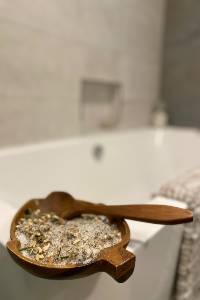
{ .1. }
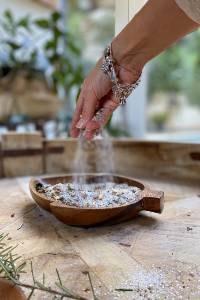
{ .2. }
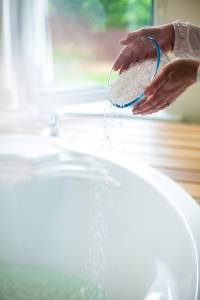
{ .3. }
The best herbs for steams and inhalations
Thyme
Herbalists swear by Thyme (Thymus vulgaris). This Southern European native is an expectorant herb, meaning it loosens mucous and enhances the release of mucous that often contains bacterial or viral materials. Expectorants are used in herbal medicine in cough, especially unproductive cough where you may be too dry or hot to easily release mucous through coughing. They’re also used to assist in deeper respiratory infections that affect the lungs. Thyme dried herb as well as the essential oil can be used in a steam bath but note the amount of essential oil considered safe in your average tabletop bowl of steam bath is 1-3 drops.
As a herbal medicine Thyme is anti-infective, cardioprotective and anti-inflammatory. It also has protective effects on the digestive system. Vapours of Thyme can be useful for disinfecting, wound healing, aches and pains and sciatica. Along with cough, cold and sore throat. 19th century hospitals soaked bandages in Thyme water to prevent infection and speed up wound healing, and bunches of Thyme were burnt to purify the home in ancient Greece and Rome. It’s been used to treat colds and chest infections, and shown to be anti-viral and anti-inflammatory. Thymol is the best chemical when it comes to relieving aches and pains, because it’s a powerful anti-inflammatory. 5
If you’re using the essential oil of Thyme: There can be up to 2.5% essential oil in the dried Thyme plant. Mostly what you’re wanting to use therapeutically are the phenols and terpenoids (thymol, carvacrol). They’re useful in respiratory conditions like bronchial catarrh, pertussis. Use 4-5 drops of Thyme essential oil in an inhalation, but avoid if pregnant and don’t use in children under 5 years old. People with epilepsy and thyroid disorders shouldn’t inhale Thyme oil. 6
Ajwain
Ajwain also contain Thymol and has a long history of use in Ayurveda for chest infections, gastro-intestinal conditions and bronchial problems. 7
Peppermint
Peppermint (Mentha x piperita) loosens mucous and it’s rich in menthol. Use it as a dried or fresh herb ideally in baths and inhalations. Note, the essential oil is too strong for steam therapy so use Spearmint oil instead. Spearmint has the menthol too, just in a milder degree. Historically it was used in Ayurveda for respiratory infections in chest rubs and cough drops. It’s also a respiratory protector according to Zhao et al (2022). 8
If you prefer to use Peppermint essential oil know that it contains 30-55% menthol,the active ingredient. It’s also used by naturopaths for digestion but should never be taken straight or drunk. Only the herb (dry or fresh) is used. Inhale 1-2 drops in hot water at a time. It’s not suitable for children under 2 yrs old, there’s a possibility it might trigger apnoea and laryngospasm in this age group. Also don’t use in ointment in young children and don’t use in inhalations if pregnant. 9
Eucalyptus
Our native Eucalyptus leaves (Eucalyptus globulus) also loosen mucous. The essential oil is used in Ayurveda as an oil rub for respiratory conditions, and of course it’s popular in western therapies too. Studies show it reduces inflammation of the airways. It’s useful in hayfever and seasonal allergies. A small 2019 Thai study found using a herbal steam bath of Eucalyptus, Ginger, Malabar Nut, Honey and Justicia for 30 minutes three times a week improved rhinitis symptoms significantly within a month. 10
Tea Tree
Tea tree oil (Melaleuca alternifolia) is particularly useful in infections including the common cold, influenza and bronchitis, but avoid in pregnancy. 9
Time for a recipe!
Decongesting Herbal Steam & Inhalation Blend
Equipment
- 1 Glass Jar
- 1 Measuring spoons and cups
Ingredients
- 1 cup Epsom salts
- 2 Tbsp Himalaya Pink Salt Crystals or powder
- 1 Tbsp Peppermint leaves Double amount if using fresh
- 1 Tbsp Tulsi (Holy Basil) leaves Double amount if using fresh
- 1 Tbsp Ginger dried Double amount if using fresh
- 1 Tbsp Ajwain (Carom)
- 1 Tbsp Thyme Double amount if using fresh
- 1 Tsp Peppermint Gum powder optional
- 1 Tsp Lemon Myrtle powder optional
- 1/2 Handful Rosemary leaves (fresh) Use 1 Tbsp if dried
Instructions
- Combine all ingredients in a glass jar. Shake or stir to mix.
- Use 1/2 cup in a steam inhalation or 2 cups in a bath. Store at room temperature for up to 12 months.
There are other great herbs you can use in for steam too like Rosemary, Lemon Myrtle, and Basil. If you have aromatic herbs growing in the garden, they’ll be useful in a restoring herbal bath steam for convalescence. Many of our Australian natives such as Myrtle family species are great as decongestants and antibacterials so feel free to try them out as well. And if adding essential oils in, remember the general rule, no more than 3 drops per inhalation, or 3-5 drops in a full length bath.
I hope you enjoyed this article and recipe, don’t forget to check out the other great articles on the blog and follow me on the socials for more health tips and hacks.
- Insta: @gaia_herbalist
- Facebook: @SulinNaturopath
- Youtube: @sulinsze


Hey there! Welcome to my world of totally natural and powerful healing medicines. Medicines from nature. Medicine from Source. I’m a naturopath and herbalist with extensive clinical experience working with a range of health conditions including hormonal, metabolic, mental health, sleep and more.
I’ve brought together years of clinical and teaching experience, academic skill and curiosity to bring you this blog. I hope you enjoy it! If you do, leave a comment, I’d love to hear from you!

References
- Alakbarov, F. 2003. Aromatic herbal baths of the ancients. Herbalgram. Iss.57. American Botanical Council.
- Kulkarni, P. S., Kamble, A. S., Damor, G. M., & Kasare, D. K. (2022). Nasal Drug Delivery In Ayurveda: A Narrative Review. Journal of Pharmaceutical Negative Results, 1372-1377.
- Gowrishankar, S., Muthumanickam, S., Kamaladevi, A., Karthika, C., Jothi, R., Boomi, P., … & Pandian, S. K. (2021). Promising phytochemicals of traditional Indian herbal steam inhalation therapy to combat COVID-19–An in silico study. Food and Chemical Toxicology, 148, 111966.
- Kulkarni, P. S., Kamble, A. S., Damor, G. M., & Kasare, D. K. (2022). Nasal Drug Delivery In Ayurveda: A Narrative Review. Journal of Pharmaceutical Negative Results, 1372-1377.
- Patil, S. M., Ramu, R., Shirahatti, P. S., Shivamallu, C., & Amachawadi, R. G. (2021). A systematic review on ethnopharmacology, phytochemistry and pharmacological aspects of Thymus vulgaris Linn. Heliyon, 7(5), e07054.
- UNIYAL, P. Utilization of cloves, Mentha, cinnamon and other essential oils in quick remedies of nasal congestion.
- Chetan, R., & Sahu, A. (2022). Chapter-4 Uses and Medicinal Value of Ajwain. AND ITS BENEFITS, 69.
- Zhao, H., Ren, S., Yang, H., Tang, S., Guo, C., Liu, M., … & Xu, H. (2022). Peppermint essential oil: Its phytochemistry, biological activity, pharmacological effect and application. Biomedicine & Pharmacotherapy, 154, 113559.
- UNIYAL, P. Utilization of cloves, Mentha, cinnamon and other essential oils in quick remedies of nasal congestion.
- Her, L., & Kanjanasilp, J. (2021). Efficacy and safety of herbal medicines for relief cough symptom in national list of essential medicines of Thailand and Lao PDR: A systematic review and Meta-analysis(Doctoral dissertation, Mahasarakham University).
- Kawagoshi, A., Shibata, K., Sugawara, K., Takahashi, H., & Saita, Y. (2018). The effects of a warmed steam inhalation on patients with chronic obstructive pulmonary disease: a cross-sectional, controlled study. Journal of Pulmonary & Respiratory Medicine, 8(4), 8-11.
- Ichiba, T., Kakiuchi, K., Suzuki, M., & Uchiyama, M. (2019). Warm steam inhalation before bedtime improved sleep quality in adult men. Evidence-Based Complementary and Alternative Medicine, 2019.





